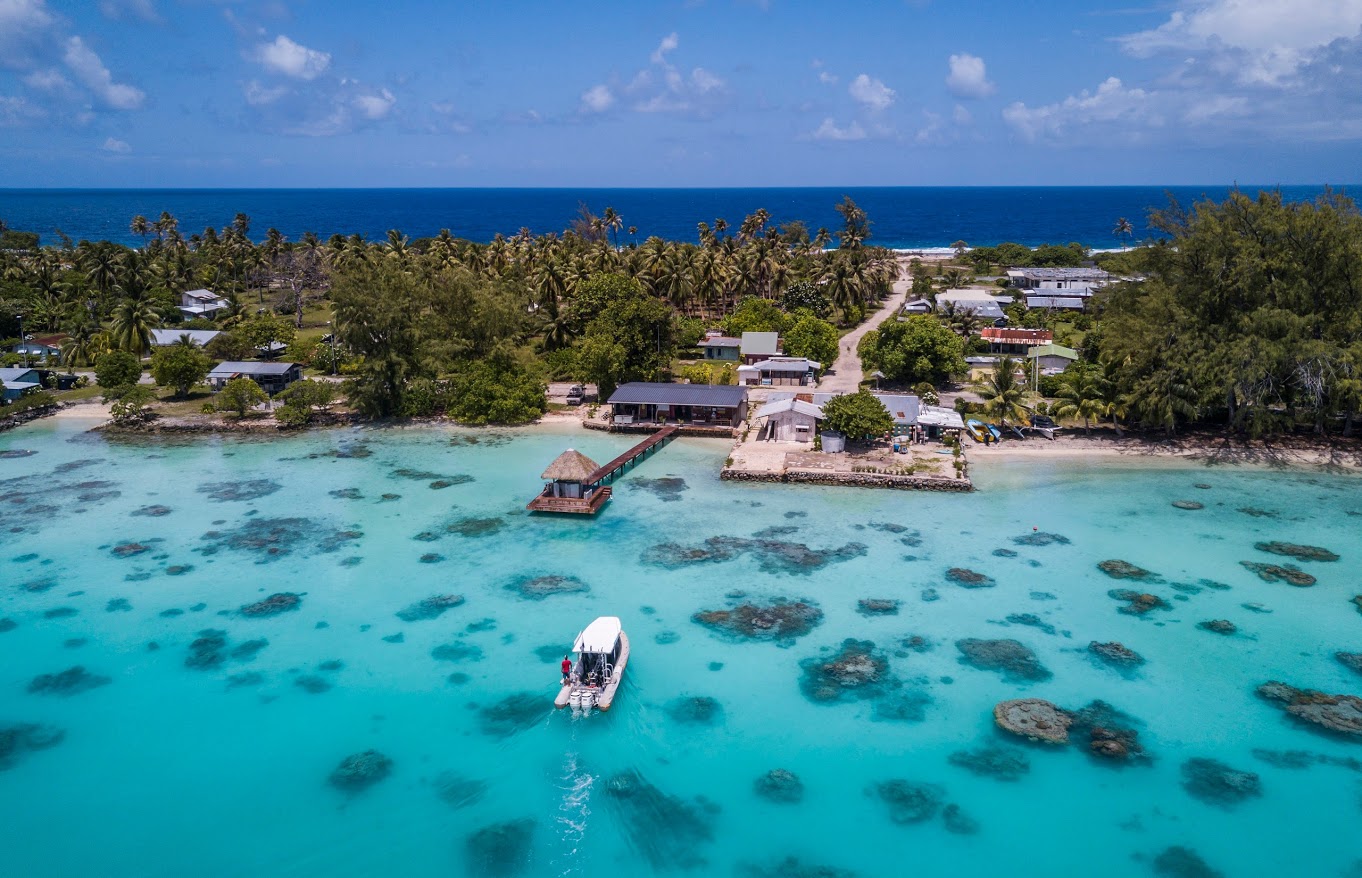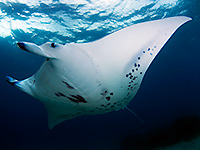The Garuae Pass, Fakarava
Fakarava and its famous Garuae pass, with a width of 5.200 fts, is the largest and probably the most beautiful in French Polynesia. I had dreamt about it for a long time and today my dream shall become a reality.
I am at Rotoava – the main village of Fakarava – in front of this impressive pass. This pass was first crossed in 1888 by R.L. Stevenson coming from San Francisco (Illustrious English literature writer and author of the “Treasure Island” and “In the South Seas”).

At the TOPDIVE center, drift dives are organized in the morning.
Being level 2 certified, I can easily participate in this dive. Two other divers would join our group (a divemaster and another level 2 scuba diver). A small briefing precedes the departure. Jean-Christophe, our dive instructor, reminds us of the safety instructions and the diving conditions.
“ Suddenly, they all leave the area…and for good reason: a 16 foot Great Hammerhead Shark glides by… ”
 Arriving on site, I am immediately captivated by the clarity of the water. We already see coral and fish directly from the boat. At that moment, I think back at the book on my beside table ‘In the South Seas ». I think about Stevenson standing on the deck of his schooner fascinated by this natural spectacle. Today, there is no wind. The pass is calm – an invitation to dive…The dive entry is breathtaking knowing that the total depth of the pass is 1600 feet. The sun’s rays disappear in the deep blue. Once in the water, the show begins: Some Tapete (Silvertip tip) sharks arrive and hover around us. The rainbow runners and the barracudas complete the scene. We continue our descent to « land » on the pass slope. The « raira » (Grey reef shark) are there! In a few seconds, we are already surrounded by a wall of sharks. Some bigger Tapete are too familiar and curious for my liking. Sharks are everywhere!
Arriving on site, I am immediately captivated by the clarity of the water. We already see coral and fish directly from the boat. At that moment, I think back at the book on my beside table ‘In the South Seas ». I think about Stevenson standing on the deck of his schooner fascinated by this natural spectacle. Today, there is no wind. The pass is calm – an invitation to dive…The dive entry is breathtaking knowing that the total depth of the pass is 1600 feet. The sun’s rays disappear in the deep blue. Once in the water, the show begins: Some Tapete (Silvertip tip) sharks arrive and hover around us. The rainbow runners and the barracudas complete the scene. We continue our descent to « land » on the pass slope. The « raira » (Grey reef shark) are there! In a few seconds, we are already surrounded by a wall of sharks. Some bigger Tapete are too familiar and curious for my liking. Sharks are everywhere!
 Suddenly, they all leave the area…and for good reason: a 16 foot Great Hammerhead Shark glides by. It passes near us: I can see its eyes and teeth. I was really impressed by its size and self-assurance as it swam past us. Time seemed to stand still in its presence as all activity froze. As it left, it seemed to be business- as- usual for the life around me.
Suddenly, they all leave the area…and for good reason: a 16 foot Great Hammerhead Shark glides by. It passes near us: I can see its eyes and teeth. I was really impressed by its size and self-assurance as it swam past us. Time seemed to stand still in its presence as all activity froze. As it left, it seemed to be business- as- usual for the life around me.
Thanks to the Nitrox, we had a lot of time for underwater observation without the necessity of decompression stops. ..Plenty of time to spot some dogtooth tunas, a shoal of crescent-tail bigeye tuna, humphead Napoleon wrasses and lot of yellow fin goatfish whose intense color breaks up with the deep blue of the ocean. As the dive progresses, we get to the drift part. We fly slowly over the canyons which are scattered with various corals. This underwater landscape is simply fantastic! My thought wander to my bedside book where Stevenson talked about a « jaw of corals » to describe this amazing place. In this part of the reef, the small tropical fish have replaced the big sharks: Surgeonfish, parrotfish, wrasses, butterflyfish, triggerfish, chromis, trumpetfish… they are all present !
We continue our itinerary to Ali Baba canyon flying over a Nurse shark sleeping on the floor. We did a break among the glass-eye fish. Few grey sharks are still “patrolling”. To cap it all, a Manta ray suddenly appears to our right side breaking up the shoal of fish and going straight to the ocean. Amazing!! In spite of our remaining 15L of Nitrox, the dive ends. Exceptional dive even if we did not stay long in Ali Baba canyon. No matter, I vow to come back for a special dive there!!
Back at the surface, my companions and I are still giddy from the after-dive experience. I now understand why this pass is the reference for scuba diving in French Polynesia. It is at the same time beautiful and ever-changing…
Whatever Stevenson would have written, I think he would have liked to dive with us that morning…
© Photos : V.Truchet / C.Dumont / L.Schmidlin / F.Legrand / S.Girardot





0 Comments